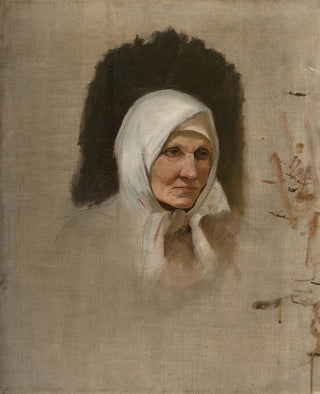Art print | Woman of the village with a white scarf - Ladislav Mednyánszky


View from behind

Frame (optional)
In the vibrant world of art, some works stand out for their ability to capture the essence of a particular era and place. "Femme du village avec un foulard blanc" by Ladislav Mednyánszky is one of those creations that transforms a simple gaze into a sensory experience. This canvas not only evokes the beauty of the subject but also the soul of a village, its traditions, and daily life. Through this piece, Mednyánszky invites us to immerse ourselves in a world where the simplicity of everyday gestures blends with striking emotional depth. The white scarf, a symbol of purity and modesty, becomes a central element that draws the eye and sparks curiosity.
Style and uniqueness of the artwork
Mednyánszky's style is characterized by fine execution and particular attention to detail. In "Femme du village avec un foulard blanc," the chosen color palette reflects the delicate nuances of the surrounding nature, while the interplay of light and shadow highlights the texture of the clothing and the softness of the facial features. The artist manages to create an intimate atmosphere, where one can almost feel the warmth of the sun caressing the subject's skin. The fluid lines and gentle shapes of the composition demonstrate a sensitivity to everyday beauty, transforming an apparently mundane scene into a work of art of great depth. Every brushstroke seems to tell a story, that of a simple yet emotionally rich life.
The artist and his influence
Ladislav Mednyánszky, a Slovak-born painter, established himself on the European art scene at the end of the 19th century. His work is marked by a constant quest for beauty in rural life and the landscapes that surround it. Influenced by the Impressionist movement, Mednyánszky was able to incorporate elements of this approach while maintaining a certain academic rigor. His work was nourished by his travels across Europe, but it was his connection to his homeland that left a profound mark on him. Through his portraits, he pays tribute to simple people, their dignity, and their daily lives, making

Matte finish

View from behind

Frame (optional)
In the vibrant world of art, some works stand out for their ability to capture the essence of a particular era and place. "Femme du village avec un foulard blanc" by Ladislav Mednyánszky is one of those creations that transforms a simple gaze into a sensory experience. This canvas not only evokes the beauty of the subject but also the soul of a village, its traditions, and daily life. Through this piece, Mednyánszky invites us to immerse ourselves in a world where the simplicity of everyday gestures blends with striking emotional depth. The white scarf, a symbol of purity and modesty, becomes a central element that draws the eye and sparks curiosity.
Style and uniqueness of the artwork
Mednyánszky's style is characterized by fine execution and particular attention to detail. In "Femme du village avec un foulard blanc," the chosen color palette reflects the delicate nuances of the surrounding nature, while the interplay of light and shadow highlights the texture of the clothing and the softness of the facial features. The artist manages to create an intimate atmosphere, where one can almost feel the warmth of the sun caressing the subject's skin. The fluid lines and gentle shapes of the composition demonstrate a sensitivity to everyday beauty, transforming an apparently mundane scene into a work of art of great depth. Every brushstroke seems to tell a story, that of a simple yet emotionally rich life.
The artist and his influence
Ladislav Mednyánszky, a Slovak-born painter, established himself on the European art scene at the end of the 19th century. His work is marked by a constant quest for beauty in rural life and the landscapes that surround it. Influenced by the Impressionist movement, Mednyánszky was able to incorporate elements of this approach while maintaining a certain academic rigor. His work was nourished by his travels across Europe, but it was his connection to his homeland that left a profound mark on him. Through his portraits, he pays tribute to simple people, their dignity, and their daily lives, making






